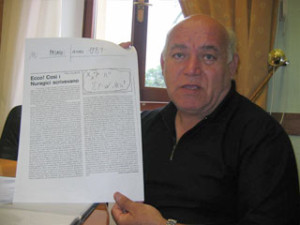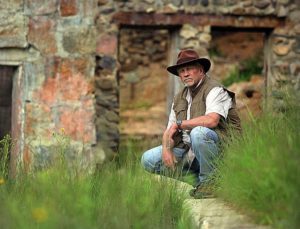Paolo Valente Poddighe
Italian Atlantology *
Italian Atlantology can be traced back to the 16th century when Fracastoro, Garimberto and Ramusio, identified the Americas as Atlantis. In fact, we should look to the 15th century when Ficino was the first to translate Plato’s entire works into Latin giving medieval Europe its first access to the complete Atlantis texts. Not much happened until 1788 when Carli attributed the destruction of Atlantis to a close encounter with a comet. In 1840, Angelo Mazzoldi proposed Italy as the location of Atlantis and as the hyper-diffusionist mother culture of the great civilisations of the Eastern Mediterranean region. He was followed by others such as Giuseppe Brex(b).
Two years after Donnelly published his Atlantis in 1882 the Italian, D’Albertis followed him and opted for the Azores as the remains of Atlantis.
Not much developed in pre-war Italy apart from Russo’s journal which ran from 1930 until 1932. After the war, other Atlantis journals were established by Gianni Belli(d) in 1956 and Bettini in 1963 and reportedly one in Trieste by Antonio Romain & Serge Robbia(c).
After that, there was a wide range of theories advanced by Italian researchers. Spedicato located Atlantis in Hispaniola, Stecchini opted for São Tomé, Barbiero, who although Croatian by birth was an admiral in the Italian Navy nominated the Antarctic as the home of Atlantis before the Flem-Aths published their Antarctic ideas. Bulloni chose the Arctic, Pincherle identified the Mandaeans as the last of the Atlanteans and Monte links Thera with Tarshish.
In recent years the most widely reported Atlantis theory to emanate from Italy came from Sergio Frau who advocates Sardinia as the original Atlantis. However, this idea is not new having been promoted by Poddighe in 1982. Frau has subsequently been supported by other commentators such as Tozzi and Novo. I cannot help feeling that there might be a trace of nationalism underlying this theory, a suspicion that I have held regarding writers of other nationalities.
The latter end of the 20th century saw the development of the Internet which enabled the instant promotion of Atlantis theories, both silly and serious, to a global audience. Italy was no exception, where websites, such as Edicolaweb that are sympathetic to the exploration of historical mysteries emerged(a).
More recently, Marin, Minella & Schievenin had The Three Ages of Atlantis[0972] published in 2014. This is an English translation of their original 2010 work. In it, they suggest that Atlantis had originally existed in Antarctica and after its destruction survivors established two other Atlantises in South America and the Mediterranean. Perhaps more credible is the theory of Capuchin friar, Antonio Moro(f)who, in 2013, suggested that Atlantis had included Iberia, the south coast of France and the west coast of Italy![0974]
I must include here a mention of the website of Pierluigi Montalbano where he and various guest authors have written many interesting articles, particularly about Sardinia and its Nuraghic past as well as Atlantis. The site is well worth a browse and as it has Google Translate built-in it is accessible to all(e).
(a) https://web.archive.org/web/20140625081839/https://edicolaweb.net/cerca.htm
(c) Atlantis, Vol 16, No.2, April 1963.
(d) 025_028.PDF (uranialigustica.altervista.org)
(e) https://pierluigimontalbano.blogspot.com/2014/04/uno-tsunami-cancello-la-civilta-nuragica.html
(f) Atlantide (archive.org) (Italian) *
Poddighe, Paolo Valente
 Paolo Valente Poddighe is an Italian researcher who claims to have been the first to have identified Sardinia (along with Corsica) as the location of Atlantis as early as 1982. This was long before Robert Ishoy proposed the same on his website(a) and two decades before Sergio Frau published his 2002 book with an identical claim. This led to accusations of plagiarism by Poddighe, who only then published his own book, Atlantide Sardegna:Isola dei Faraoni [0711] (Atlantis Sardinia: Island of the Pharaohs).
Paolo Valente Poddighe is an Italian researcher who claims to have been the first to have identified Sardinia (along with Corsica) as the location of Atlantis as early as 1982. This was long before Robert Ishoy proposed the same on his website(a) and two decades before Sergio Frau published his 2002 book with an identical claim. This led to accusations of plagiarism by Poddighe, who only then published his own book, Atlantide Sardegna:Isola dei Faraoni [0711] (Atlantis Sardinia: Island of the Pharaohs).
Where Frau locates the Pillars of Heracles at the Strait of Sicily, Poddighe opted for the Strait of Bonifacio between Sardinia and Corsica, which would imply that the islands of Atlantis ‘beyond the Pillars’ would have to be the Balearic Islands, which offer few features to match Plato’s description of Atlantis. Consequently, I am personally inclined towards siting them further east at the Strait of Messina.>In which case, it could be reasonably argued that the islands ‘beyond the Pillars’ were Sardinia and Corsica.<
Frau, Sergio *
 Sergio Frau was born in 1949 and is a journalist with Italy’s leading daily newspaper La Repubblica. He is also the author of a hefty 672-page volume, Le Collone d’Ercole: Un’inchiesta[302] that firmly places Atlantis in Sardinia and the Pillars of Hercules in the Strait of Sicily between Tunisia and Sicily. He supports this contention with references to ancient writers such as Herodotus and Dicaearchus.
Sergio Frau was born in 1949 and is a journalist with Italy’s leading daily newspaper La Repubblica. He is also the author of a hefty 672-page volume, Le Collone d’Ercole: Un’inchiesta[302] that firmly places Atlantis in Sardinia and the Pillars of Hercules in the Strait of Sicily between Tunisia and Sicily. He supports this contention with references to ancient writers such as Herodotus and Dicaearchus.
So far, Frau’s book is only available in Italian and from 2008 in German(c).
Professor Louis Godart offered wholehearted support for Frau’s location for the Pillars of Herakles in a short paper in Italian(o) and English (Archive 7096).
Frau contends that a catastrophic inundation of some sort destroyed the mysterious ancient civilisation on Sardinia known as the Nuraghi, after whom the numerous ancient towers on the islands are named. A megatsunami around 1200 BC is accepted to have struck from the south. A more specific date on offer is 1175 BC. However, Carthaginian and Roman remains have been found underneath the sediment deposited by this tsunami conflicting with the date and greatly weakening the suggestion that Atlantis was destroyed by this event (i).
Frau believes that some of the survivors migrated to the Italian mainland and founded the Etruscan civilisation, while others formed part of the Sea Peoples who attacked Egypt.
His book sold over 30,000 copies in Italy, his theory received favourable attention from UNESCO and an exhibition based on his work has been shown in Paris and Rome. This is in sharp contrast to the 250 historians who reportedly denounced his theory. Then there are many others, such as Hannah Fielding, the novelist, who is very attracted to Frau’s ideas(b).
A collection of reviews of Frau’s book, in English, is available(k).
Frau has received support for his theory from the well-known geologist, Mario Tozzi. Another commentator, Silvio Diego Novo has also given his backing to the idea(b).
Robert Ishoy proposed a similar theory(a) on the Internet at least two years before Frau had his book published. However, the earliest claim that Atlantis had existed on Sardinia was made in 1982 by Paolo Valente Poddighe, who now accuses Frau of plagiarism.
The Atlantisforschung.de website has also offered a review of Frau’s book on the tenth anniversary of its publication including a number of criticisms and particularly its inability to generate any great support in either academic or Atlantis circles.(n)
Although the media have generally given a positive response to Frau’s book, Thorwald C. Franke has panned it, denouncing it as pseudo-science(d), but reluctantly conceded that Frau “could nevertheless be partially right! For the record, I agree with Franke’s limited support.
In addition, at the instigation of Alessandro Usai, 71 Sardinian archaeologists, geologists and historians have signed a 21-point refutation of Frau’s theory(e). Antonio Usai (relation?) has also endorsed the criticism in this document(j). An English/Italian version of the document is available as Archive 2704.
Nevertheless, the Atlantika has published over twenty short papers, generally supportive of Frau from what has been called a ‘Jury of Experts’(m). However, the general focus of that support was not related to Atlantis but to endorse the credibility of Frau’s location of the Pillars of Herakles before the term was applied to the Strait of Gibraltar. Frau maintains that it was used to describe a location at the Strait of Sicily. This brings us to another question, which Strait of Sicily? In ancient times, that term was also a reference to the Strait of Messina, which, for me, makes more sense as today’s Strait of Sicily does not conform to any definition of a ‘strait’, while the Strait of Messina is a perfect example.
In August 2016, Frau received another round of publicity following an interview with Sputnik news media(f). The interview added nothing of consequence, although the text was copied by other media outlets. Nevertheless, this did not hold back Jason Colavito from his standard atlantiphobic attack(g).
So far, Frau’s book is only available in Italian and German(c). In 2017, Frau published a sequel to his Le Collone d’Ercole, entitled Omphalos[1553] in which he expands on aspects of his Sardinian location for Atlantis in a hefty 1154-page volume, which once again is currently only available in Italian. He highlights the fact that lying on the 40th parallel, Sardinia is virtually halfway between the west coast of America ((11,359 km distant) and the Pacific coast of Japan (11,350) and so can be truly considered the navel (or omphalos) of the world! It should be obvious that Sardinia is also midway between any number of other paired locations, so what?
An extensive collection of snippets from Omphalos is also available(l).
2018 saw Frau win a defamation case against Fabrizio Frongia and damages of 22,500 Euro(h), as a result of comments in Frongia’s book Le torri di Atlantide[1609] (The Towers of Atlantis).
(a) http://www.atlantisdiscovered.org/Home.htm
(b) Hannah Fielding: Home – Award-Winning Romantic Books (archive.org)
(c) https://www.atlantis-scout.de/index_engl.htm
(d) https://www.atlantis-scout.de/atlantis-sergio-frau-english.htm
(e) “La Sardegna (che non esiste) di Sergio Frau”, l’invito di Alessandro (…) – Atlantikà (archive.org) (Italian) *
(f) https://sputniknews.com/europe/20160824/1044602988/sardinia-new-lost-atlantis.html
(h) https://www.omphalos-sardegna.it/crollano-le-torri-di-atlantide-giustizia-per-sergio-frau/
(i) https://scienze.fanpage.it/sardegna-atlantide-la-tesi-dello-tsunami-secondo-gli-specialisti/ (Italian)
(j) http://www.lavocedifiore.org/SPIP/article.php3?id_article=3095
(k) http://www.colonnedercole.info/pdf/txtenglish.pdf
(l) Omphalos the book – OMPHALOS (omphalos-sardegna.it)
(m) La Giuria degli Esperti – Atlantikà (archive.org) *
(n) Sergio Frau – Atlantisforschung.de
(o) http://www.colonnedercole.it/spip/spip.php?article15 (Italian)
Ishoy, Robert Paul
Robert Paul Ishoy is a graduate of California State University Fresno (CSUF) where he got his BA Degree in History and an Associate’s Degree in Social Sciences. His website tells us that “Since completion of his education Robert has served in the military as an intelligence specialist and as a paratrooper in the 82nd Airborne Division. After the military, Robert has worked in Corporate Security and Loss Prevention for major retail and distribution companies and is currently employed as a government contractor under the Department of Defense as an intelligence specialist.”
His thesis, which promotes the idea that Sardinia was the site of Atlantis, was written during his senior year at CSUF. In 2010 he was proposing a multidisciplinary expedition to the Italian island in order to explore and investigate in situ the evidence for the possible existence of Atlantis there. This expedition is now planned for 2015.
A promotional video is available on YouTube(b).
Ishoy maintains a website(a) to support his views and is at pains to point out that his theory was in the public domain at least two years before Sergio Frau had his book published. However, the earliest claim to the Sardinian Hypothesis must go to Paolo Valente Poddighe who put it forward in 1982. Poddighe has accused Frau of plagiarism.
It is remarkable that in the same week that Sergio Frau generated renewed interest in his ‘Atlantis in Sardinia’ theory that news emerged(c) that Ishoy, who promoted the same idea three decades ago has now had the support of National Geographic, who were planning a documentary on the concept, co-produced by James Cameron, of Titanic fame and Simcha Jacobovici, both of whom were also responsible for the documentary The Lost Tomb of Jesus. However, Diaz-Montexano believed that the focus of the documentary was to be on his theories!
In the end the over-hyped NG documentary proved nothing.
(a) https://www.atlantisdiscovered.org/Home.htm
(b) https://www.youtube.com/watch?v=LwXaByB2-no&feature=youtu.be
(d) https://web.archive.org/web/20191202150418/https://atlantisng.com/en/<
Identity of the Atlanteans *
The Identity of the Atlanteans has produced a range of speculative suggestions nearly as extensive as that of the proposed locations for Plato’s lost island. However, it is highly probable that we already know who the Atlanteans were, but under a different name.
The list below includes some of the more popular suggestions and as such is not necessarily exhaustive. While researchers have proposed particular locations for Atlantis, not all have identified an archaeologically identified culture to go with their chosen location. The problem is that most of the places suggested have endured successive invasions over the millennia by different peoples.
It would seem therefore that the most fruitful approach to solving the problem of identifying the Atlanteans would be to first focus on trying to determine the date of the demise of Atlantis. This should reduce the number of possible candidates, making it easier to identify the Atlanteans.
A final point to consider is that the historical Atlanteans were a military alliance, and as such may have included more than one or none of those listed here. The mythological Atlanteans, who included the five sets of male twins and their successors would be expected to share a common culture, whereas military coalitions are frequently more disparate.
Basques: William Lewy d’Abartiague, Edward Taylor Fletcher
Berbers: Alberto Arecchi, Alf Bajocco, Ulrich Hofmann, Jacques Gossart, Ibn Khaldun
British: William Comyns Beaumont, E. J. de Meester, Donald Ingram, George H. Cooper, Anthony Roberts, Paul Dunbavin.
Cro-Magnons: R. Cedric Leonard, Theosophists, Georges Poisson, Robert B. Stacy-Judd, Kurt Bilau, Louis Charpentier
Etruscans: Richard W. Welch, Frank Joseph *
Guanches: B. L. Bogaevsky, Bory de Saint Vincent, Boris F. Dobrynin, Eugène Pégot-Ogier
Irish: Ulf Erlingsson, George H. Cooper, John Whitehurst, Thomas Dietrich, Padraig A. Ó Síocháin, Lewis Spence,
Maltese: Anton Mifsud, Francis Xavier Aloisio, Kevin Falzon, Bibischok, Joseph Bosco, David Calvert-Orange, Giorgio Grongnet de Vasse, Albert Nikas, Joseph S. Ellul, Francis Galea, Tammam Kisrawi, Charles Savona-Ventura, Hubert Zeitlmair.
Maya: Robert B. Stacy-Judd, Charles Gates Dawes, Colin Wilson, Adrian Gilbert, L. M. Hosea, Augustus le Plongeon, Teobert Maler, Joachim Rittstieg, Lewis Spence, Edward Herbert Thompson, Jean-Frédérick de Waldeck,
Megalith Builders: Lucien Gerardin, Paolo Marini, Sylvain Tristan, Jean Deruelle, Alan Butler, Alfred deGrazia, Helmut Tributsch, Hank Harrison, Walter Schilling, Robert Temple, Manuel Vega
Minoans: K.T. Frost, James Baikie, Walter Leaf, Edwin Balch, Donald A. Mackenzie, Ralph Magoffin, Spyridon Marinatos, Georges Poisson, Wilhelm Brandenstein, A. Galanopoulos, J. G. Bennett, Rhys Carpenter, P.B.S. Andrews, Edward Bacon, Willy Ley, J.V. Luce, James W. Mavor, Henry M. Eichner, Prince Michael of Greece, Nicholas Platon, N.W. Tschoegl, Richard Mooney, Rupert Furneaux, Martin Ebon, Francis Hitching, Charles Pellegrino, Rodney Castleden, Graham Phillips, Jacques Lebeau, Luana Monte, Fredrik Bruins, Gavin Menzies, Lee R. Kerr, Daniel P. Buckley.
Persians: August Hunt, Pierre-André Latreille, William Henry Babcock, Hans Diller.
Phoenicians: Jonas Bergman, Robert Prutz,
Sardinians: Paolo Valente Poddighe, Robert Paul Ishoy, Sergio Frau, Mario Tozzi, Diego Silvio Novo, Antonio Usai, Giuseppe Mura.
Sicilians: Phyllis Young Forsyth, Thorwald C. Franke, Axel Hausmann, Peter Jakubowski, Alfred E. Schmeck, M. Rapisarda,
Swedes: Johannes Bureus, Olaf Rudbeck
Sea Peoples: Wilhelm Christ, Jürgen Spanuth, Spyridon Marinatos, Rainer W. Kühne, John V. Luce, Theodor Gomperz, Herwig Görgemanns , Tony O’Connell, Sean Welsh, Thorwald C. Franke, Werner Wickboldt.

